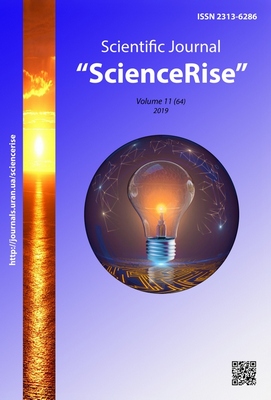Исследование повторяющегося всплеска FRB 121102 как излучение от каспа на сверхпроводящей космической струне
DOI:
https://doi.org/10.15587/2313-8416.2019.186487Ключевые слова:
космические струны, фазовый переход в ранней Вселенной, ультрарелятивистская плазма, быстрые радиовсплески, FRB 121102Аннотация
Космические струны – топологические дефекты, реликты ранней Вселенной, которые могли формироваться во время фазовых переходов полей со спонтанно нарушенной симметрией. Было показано, что внегалактические быстрые радиовспышки можно объяснить как излучение от сверхпроводящих космических струн. В рамках нашей модели было исследовано FRB 121102 – первый открытый повторяющийся быстрый радиовсплеск. Для нескольких групп событий всплесков был получен параметр, характеризующий возможный источник излучения – петлю космической струны, а именно энергетический масштаб фазового перехода, во время которого струна образовалась
Библиографические ссылки
Thornton, D., Stappers, B., Bailes, M., Barsdell, B., Bates, S., Bhat, N. D. R. et. al. (2013). A Population of Fast Radio Bursts at Cosmological Distances. Science, 341 (6141), 53–56. doi: http://doi.org/10.1126/science.1236789
Amiri, M., Bandura, K., Bhardwaj, M. et. al. (2019). A second source of repeating fast radio bursts. Nature, 566 (7743), 235–238. doi: http://doi.org/10.1038/s41586-018-0864-x
Fedorova, V. A., Rodin, A. E. (2019). Detection of nine new Fast Radio Bursts in the direction of the galaxy M31 and M33 at the frequency 111 MHz at the radio telescope BSA LPI. ATel, 12899. Available at: http://www.astronomerstelegram.org/?read=12899
Lorimer, D. R., Bailes, M., McLaughlin, M. A., Narkevic, D. J., Crawford, F. (2007). A Bright Millisecond Radio Burst of Extragalactic Origin. Science, 318 (5851), 777–780. doi: http://doi.org/10.1126/science.1147532
Zadorozhna, L. (2015). Fast radio bursts as electromagnetic radiation from cusps on superconducting cosmic strings. Advances in Astronomy and Space Physics, 5 (1), 43–50. doi: http://doi.org/10.17721/2227-1481.5.43-50
Spitler, L. G., Cordes, J. M., Hessels, J. W. T., Lorimer, D. R., McLaughlin, M. A., Chatterjee, S. et. al. (2014). Fast radio burst discovered in the arecibo pulsar ALFA survey. The Astrophysical Journal, 790 (2), 101–119. doi: http://doi.org/10.1088/0004-637x/790/2/101
Andersen, B. C., Bandura, K., Bhardwaj, M., Boubel, P. et. al. (2019). CHIME/FRB Detection of Eight New Repeating Fast Radio Burst Sources. The Astrophysical Journal, 885 (1), 24–64. doi: http://doi.org/10.3847/2041-8213/ab4a80
Marcote, B., Paragi, Z., Hessels, J. W. T., Keimpema, A., Langevelde, H. J. van, Huang, Y. et. al. (2017). The Repeating Fast Radio Burst FRB 121102 as Seen on Milliarcsecond Angular Scales. The Astrophysical Journal, 834 (2), 8–17. doi: http://doi.org/10.3847/2041-8213/834/2/l8
Gajjar, V., Siemion, A. P. V., Price, D. C., Law, C. J., Michilli, D., Hessels, J. W. T. et. al. (2018). Highest Frequency Detection of FRB 121102 at 4–8 GHz Using the Breakthrough Listen Digital Backend at the Green Bank Telescope. The Astrophysical Journal, 863 (1), 2–9. doi: http://doi.org/10.3847/1538-4357/aad005
Chatterjee, S., Law, C. J., Wharton, R. S., Burke-Spolaor, S., Hessels, J. W. T., Bower, G. C. et. al. (2017). A direct localization of a fast radio burst and its host. Nature, 541 (7635), 58–61. doi: http://doi.org/10.1038/nature20797
Scholz, P., Spitler, L. G., Hessels, J. W. T., Chatterjee, S., Cordes, J. M., Kaspi, V. M. et. al. (2016). The repeating Fast Radio Burst FRB 121102: Multi-wavelength observations and additional bursts. The Astrophysical Journal, 833 (2), 177–194. doi: http://doi.org/10.3847/1538-4357/833/2/177
Price, D. C., Gajjar, V., Rosenthal, L., Hallinan, G., Croft, S., DeBoer, D. et. al. (2018). No Bursts Detected from FRB121102 in Two 5 hr Observing Campaigns with the Robert C. Byrd Green Bank Telescope. Research Notes of the AAS, 2 (1), 30. doi: http://doi.org/10.3847/2515-5172/aaaf69
Spitler, L. G., Scholz, P., Hessels, J. W. T., Bogdanov, S., Brazier, A., Camilo, F. et. al. (2016). A repeating fast radio burst. Nature, 531 (7593), 202–205. doi: http://doi.org/10.1038/nature17168
Law, C. J., Abruzzo, M. W., Bassa, C. G., Bower, G. C., Burke-Spolaor, S., Butler, B. J. et. al. (2017). A Multi-telescope Campaign on FRB 121102: Implications for the FRB Population. The Astrophysical Journal, 850 (1), 76. doi: http://doi.org/10.3847/1538-4357/aa9700
Michilli, D., Seymour, A., Hessels, J. W. T., Spitler, L. G., Gajjar, V., Archibald, A. M. et. al. (2018). An extreme magneto-ionic environment associated with the fast radio burst source FRB 121102. Nature, 553 (7687), 182–185. doi: http://doi.org/10.1038/nature25149
Zhang, Y. G., Gajjar, V., Foster, G., Siemion, A., Cordes, J., Law, C., Wang, Y. (2018). Fast Radio Burst 121102 Pulse Detection and Periodicity: A Machine Learning Approach. The Astrophysical Journal, 866 (2), 149. doi: http://doi.org/10.3847/1538-4357/aadf31
Tendulkar, S. P., Bassa, C. G., Cordes, J. M., Bower, G. C., Law, C. J., Chatterjee, S. et. al. (2017). The Host Galaxy and Redshift of the Repeating Fast Radio Burst FRB 121102. The Astrophysical Journal, 834 (2), 7. doi: http://doi.org/10.3847/2041-8213/834/2/l7
Vachaspati, T. (2008). Cosmic Sparks from Superconducting Strings. Physical Review Letters, 101 (14), 1301–1305. doi: http://doi.org/10.1103/physrevlett.101.141301
Siemens, X., Creighton, J., Maor, I., Majumder, S. R., Cannon, K., Read, J. (2006). Gravitational wave bursts from cosmic (super)strings: Quantitative analysis and constraints. Physical Review D, 73 (10), 5001–5018. doi: http://doi.org/10.1103/physrevd.73.105001
Ringeval, C., Sakellariadou, M., Bouchet, F. R. (2007). Cosmological evolution of cosmic string loops. Journal of Cosmology and Astroparticle Physics, 2007 (2), 23–35. doi: http://doi.org/10.1088/1475-7516/2007/02/023
Berezinsky, V., Hnatyk, B., Vilenkin, A. (2001). Gamma ray bursts from superconducting cosmic strings. Physical Review D, 64 (4), 3004–3030. doi: http://doi.org/10.1103/physrevd.64.043004
Загрузки
Опубликован
Выпуск
Раздел
Лицензия
Copyright (c) 2019 Lidiia Zadorozhna, O. Teslyk

Это произведение доступно по лицензии Creative Commons «Attribution» («Атрибуция») 4.0 Всемирная.
Наше издание использует положения об авторских правах Creative Commons CC BY для журналов открытого доступа.
Авторы, которые публикуются в этом журнале, соглашаются со следующими условиями:
1. Авторы оставляют за собой право на авторство своей работы и передают журналу право первой публикации этой работы на условиях лицензии Creative Commons CC BY, которая позволяет другим лицам свободно распространять опубликованную работу с обязательной ссылкой на авторов оригинальной работы и первую публикацию работы в этом журнале.
2. Авторы имеют право заключать самостоятельные дополнительные соглашения, которые касаются неэксклюзивного распространения работы в том виде, в котором она была опубликована этим журналом (например, размещать работу в электронном хранилище учреждения или публиковать в составе монографии), при условии сохранения ссылки на первую публикацию работы в этом журнале .

